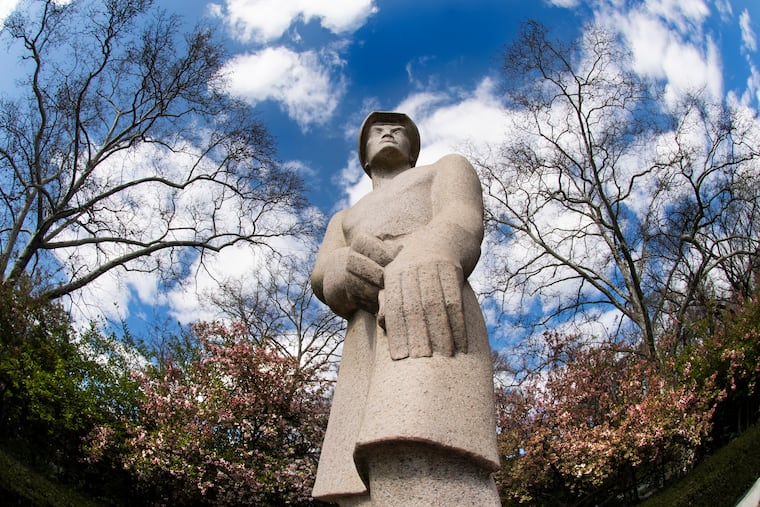Taking a lesson from the Samuel Memorial, let’s rethink the proposed National Garden of American Heroes
When we raise our sights beyond individual heroes, we invite the possibilities of monuments built on character and contributions.

Last month, President Donald Trump revived his executive order for a National Garden of American Heroes, a public art project that would memorialize 250 of “the greatest Americans to ever live.” When initially announced in 2021 at the end of his first term, the idea was met with criticism before being revoked by President Joe Biden. Now that the project is back with plans for completion “as expeditiously as possible,” the controversy has also revived.
Who are the heroes to memorialize? So far, the handpicked list of 244 includes Christopher Columbus and Alex Trebek, Andrew Jackson and Whitney Houston, Annie Oakley and Dr. Seuss, John Wayne and Sacagawea, Kobe Bryant and Lauren Bacall. See the list here.
Before sculptors take chisel to stone, it would be worthwhile to review previous projects with similar ambitions, and how they were received.
In 1901 Berlin, a grand promenade lined with statues of Prussian rulers was officially dubbed Siegesallee, or Victory Avenue. Berliners mocked it as “Avenue of the Puppets.” That project no longer survives. In Padua, Italy, Prato della Valle, an oval canal in a park, was lined with 78 figures on pedestals. Everyone is male, an oversight that came to haunt the project. These displays and others were said to inspire Ellen Phillips Samuel, a wealthy visitor from Philadelphia, who funded an American version.
There are valuable takeaways from the Ellen Phillips Samuel Memorial, which resides on a 2,000-foot stretch of the Schuylkill riverbank from Boathouse Row to the Girard Avenue Bridge.
“On top of this embankment,” read Samuel’s philanthropic bequest dated 1907, “it is my will to have erected at distances of one hundred (100) feet apart, on high granite pedestals of uniform shape and size, statuary emblematic of the history of America, ranging in time from the earliest settlers of America to the present era.”
These sculptures were to be “arranged in chronological order, the earliest at the south end, and going on to the present time at the north end.”
As recipient of Samuel’s bequest, the Fairmount Park Art Association was soon confronted by several challenging questions — especially who should be featured to represent American history. Aware of inevitable complexities and controversies, Samuel had decided to not dictate specific people or even specific sculptors. Instead, she called for a competition to find the most appropriate and creative proposals, but not until after her and her husband’s demise.
After Samuel’s death in 1913, her husband, J. Bunford Samuel, attempted to jump-start the project by commissioning the first statue. Thorfinn Karlsefni, an 11th-century Icelandic explorer, represented the earliest settlers.
In recent years, that Viking, as it became known, evolved into a gathering place for white supremacy groups, was repeatedly vandalized, spray-painted with anti-Nazi symbols, and, in 2018, toppled into the Schuylkill.
As for the rest of the project, the art association revisited the project’s core premise. Instead of representing actual historical figures — fame, foibles, and all — the Samuel Memorial would focus on the overarching characteristics and types of individuals who shaped America. No single heroic individual would be commemorated or memorialized.
A few of the sculptures focused on historical narratives, including Settling the Seaboard and Spanning the Continent, but many more depicted the types who shaped the nation. These included The Immigrant, The Ploughman, The Scientist, The Miner, The Poet, The Preacher, and The Slave.
Real people, especially heroic figures, are guaranteed to fall short. They can be misconstrued and misrepresented and even subject to attack.
Samuel had the right idea leaving those choices open for discussion. And more than a century later, those kinds of conversations continue to add value to both process and product. When we raise our sights beyond individual heroes, we invite the possibilities for a greater monumentscape built on character and contributions.
Instead of polarizing discussions as to who has earned a spot in our collective public memory and who has not, we can have a discourse that unites and inspires. That’s what a conversation about a National Garden of American Character — not American Heroes — would offer.
Kenneth Finkel is professor emeritus of history at Temple University, and blogs at PhillyHistory.org. For more than 10 years he has served on the board of directors of the nonprofit Association for Public Art, which was founded in 1872 as the Fairmount Park Art Association.